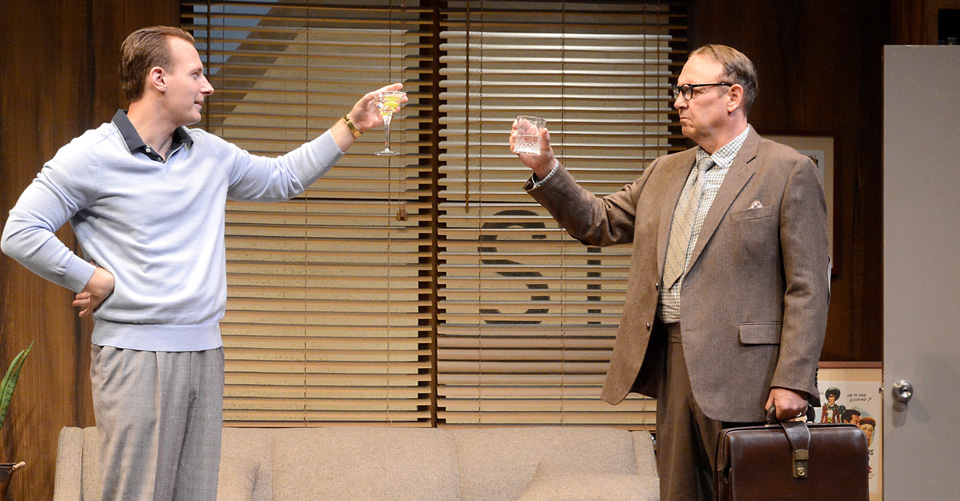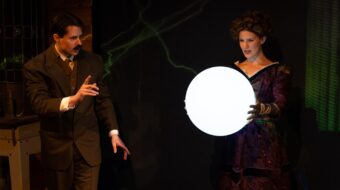
What are the odds? A pair of plays may have theatergoers and film buffs seeing double. Within a week, by sheer coincidence, two different shows about writer/director Billy Wilder have opened on SoCal stages. At the heart of both is the 1944 film noir classic Double Indemnity, which Wilder helmed and co-wrote with maestro of mysteries and crime fiction, Raymond Chandler.
Wilder was a European Jewish screenwriter who fled the Nazis during the 1930s and found refuge in Hollywood, where over the course of a stellar, eclectic 40-year career he co-wrote and helmed many movies starring La-La-Land legends of Hollywood’s Golden Age. His titles include Five Graves to Cairo, The Lost Weekend, Sunset Boulevard, Sabrina, Witness for the Prosecution, Some Like It Hot, and The Apartment.
Wilder started out as a journalist, and for him the written word remained paramount. He collaborated closely with wordsmiths, notably Charles Brackett and I.A.L. Diamond. In May 1943 he commenced co-writing Double Indemnity with Raymond Chandler, selected because of his mastery of hardboiled detective stories. The American-British novelist began writing for pulp magazines in 1933. His first full-length book, The Big Sleep (1939), featured private eye Philip Marlowe, who upheld his own code of honor in a decidedly dishonorable, crime-ridden world. Humphrey Bogart starred in the 1946 movie, although Double Indemnity was the first time Chandler worked on a screenplay per se.
Mike Bencivenga’s Billy & Ray, directed by Michael Matthews at the Laguna Playhouse, focuses on Chandler’s (Nick Searcy) rocky collaboration with Wilder (Blake Ellis), while they transformed James M. Cain’s novel into a script at Wilder’s Paramount lot office (with a superbly realistic set complete with overturned wastebasket and crumpled papers on the floor – designed by Stephen Gifford). Generous exposition about the principals was necessary for many theatergoers who know little about the lead characters, which may be what bogged down the first act.
Their clashes, quirky personalities, and drinking are established for about an hour, as the much put-upon Paramount producer Joe Sistrom (Scott Lowell) shepherds the production through the treacherous shoals of the Hollywood studio system. The trio are held together by maternal Helen Hernandez (Joanna Strapp), the personal assistant of Wilder and Charles Brackett (their breakup led to Chandler’s hiring). Helen pours drinks, cajoles, types, and smooths the combative characters’ ruffled feathers.
During Act II, the backgrounding largely out of the way, Billy & Ray really takes off. The acting is topnotch, as the writers with their conflicting personalities and competing visions and styles come to blows. The easily offended Chandler storms off the lot, but as Double Indemnity goes on to score seven Academy Award nominations – including Best Picture, director and writing – the onetime rivals develop a grudging mutual affection. Having made his biggest hit so far in his adopted land, a forgiving Wilder shrugs off their mortal combat, telling Chandler: “No spark, no sparkle.” Although the noir masterpiece did not actually win any Oscars, it was the finest film Sistrom ever produced.
Bencivenga’s well researched script is insightful. Helen’s seemingly tossed-off plot ideas wind up in the film, although the real-life Hernandez apparently had no screen credits. The well acted dramedy is full of revelations – in particular, as to what caused the heavy-drinking title characters’ inner demons, and how they channeled their traumas into art.
A World War I veteran, Chandler seems to have sublimated his PTSD from the horrors of trench warfare into the violence Marlowe and company witnessed and experienced in searing novels like 1953’s The Long Goodbye, which is full of anti-capitalist passages Karl Marx could have written if fiction had been his calling.
The playwright also reveals what was beneath Wilder’s cynical, wisecracking façade. As Nazism conquers Europe unleashing the Holocaust, Wilder’s mother and family are ensnared and sent to the genocide camps. From afar, using his Hollywood hotshot influence with the U.S. State Department, Wilder tries keeping tabs on and possibly rescuing them. Once the Allies are victorious, Wilder returned to Europe and went to the forced labor camps, desperately trying to locate his doomed relatives. As Bencivenga indicates, the future director of the 1953 POW drama Stalag 17 (starring the also Jewish Otto Preminger as the camp’s German commandant) even made a documentary about the camps called Death Mills. The 1945 short shot at Bergen-Belsen is Wilder’s only nonfiction film.
This is the central point of The Stand-In, playing simultaneously and separately at L.A.’s Bootleg Theater. Here, however, the dueling Billy and Ray of The Stand-In are not the protagonists. While Wilder (Chris Schultz) plays an important role, the eponymous character is Kasia (Fayelyn Bilodeau), a 25-ish Polish refugee who, through a magical realist flourish, has escaped war-torn Europe to be washed ashore at SoCal, where she’s discovered and “rescued” by Max (Jeremy Mitchell).
Max just so happens to be Double Indemnity’s director of photography (though according to IMDB.com, John F. Seitz has the cinematography credit). As Kasia’s stepping stone, Max provides the Polish newcomer with her entrée to Hollywood, where she starts out as Indemnity co-star Barbara Stanwyck’s (McCready Baker) stand-in, thus developing a career in front of the cameras.
Much of The Stand-In revolves around the plight of anti-Nazi European artists living in Hollywood, not all of whom were Jews. Marlene Dietrich left Germany before Hitler became Germany’s chancellor in 1933 and is a key character in this large cast, depicted by Alicia Hoge Adams, who co-wrote this excellent play with Peter Monro. As the fabled Marlene, Adams is at a disadvantage, for Dietrich was a luminously styled and lavishly photographed beauty familiar to many movie fans. It’s hard to live up to a legend.
Marlene wears an obvious blonde wig, perhaps a deliberate point about Tinseltown artifice. In any case, Dietrich – who is in her forties – is enamored of Kasia’s youth, and while she’s trying on some of Dietrich’s duds, using her star power, Marlene, shall we say, pulls a “Trump” on the younger woman (although it’s a consensual encounter). In a double role, Adams also plays Kasia’s Polish mother, bestowing an Oedipal tinge on the play.
Although Chandler is a much smaller part than in Billy & Ray, Paul Dillon is outstanding as the liquor-ravaged wordsmith who also engages in pitched battles with Wilder in this production. Other standouts who etch their characterizations in stone include Stephen Simon as Indemnity co-star Fred MacMurray, whom he depicts as an affable dunce who could have acted in more serious films, but traded artistry for playing fluffy fare on both big and little screens. Michael Dunn likewise shows panache in dual roles as Indemnity co-star Edward G. Robinson and a megaphone-touting assistant director.
The Stand-In is adroitly directed by Patrick Murphy, with well-done projections designed by Hana S. Kim on David Offner’s set. In the end, as Kasia reinvents herself in the land of make believe, given a second chance by America and Hollywood, she was perhaps a “stand-in” for all those victims of the Holocaust who never had a chance to star in their own lives, let alone on the silver screen.
Both plays have their merits. Billy & Ray has a third of the cast, highlights the relationship between the two titular talents, and is far more conventionally theatrical in that it rests upon dialogue and acting. The Stand-In is more cinematic, with many scenic changes, flashbacks and metaphors.
We may be wild about Wilder, but the cynicism Wilder’s oeuvre is known for suggests that he may not necessarily have been so wild about us – the human race.
BILLY & RAY plays Weds. – Sat. at 7:30 pm, plus Sat. at 2:00 pm and Sun. at 1:00 pm, with additional performances on Thurs. Oct. 20 and 27 at 2:00 pm through Oct. 30 at the Laguna Playhouse, 606 Laguna Canyon Road, Laguna Beach, CA 92651. For more info: (949) 497-2787; www.LagunaPlayhouse.com.
THE STAND-IN plays Thurs., Fri. and Sat. at 7:00 pm and Sun. at 2:00 pm through Nov. 5 at Bootleg Theater, 2220 Beverly Blvd., L.A. For more info: (213) 389-3856; www.bootlegtheater.org.












Comments